+Search query
-Structure paper
| Title | A conserved arginine residue is critical for stabilizing the N2 FeS cluster in mitochondrial complex I. |
|---|---|
| Journal, issue, pages | J Biol Chem, Vol. 296, Page 100474, Year 2021 |
| Publish date | Feb 26, 2021 |
 Authors Authors | Mikhail A Hameedi / Daniel N Grba / Katherine H Richardson / Andrew J Y Jones / Wei Song / Maxie M Roessler / John J Wright / Judy Hirst /  |
| PubMed Abstract | Respiratory complex I (NADH:ubiquinone oxidoreductase), the first enzyme of the electron-transport chain, captures the free energy released by NADH oxidation and ubiquinone reduction to translocate ...Respiratory complex I (NADH:ubiquinone oxidoreductase), the first enzyme of the electron-transport chain, captures the free energy released by NADH oxidation and ubiquinone reduction to translocate protons across an energy-transducing membrane and drive ATP synthesis during oxidative phosphorylation. The cofactor that transfers the electrons directly to ubiquinone is an iron-sulfur cluster (N2) located in the NDUFS2/NUCM subunit. A nearby arginine residue (R121), which forms part of the second coordination sphere of the N2 cluster, is known to be posttranslationally dimethylated but its functional and structural significance are not known. Here, we show that mutations of this arginine residue (R121M/K) abolish the quinone-reductase activity, concomitant with disappearance of the N2 signature from the electron paramagnetic resonance (EPR) spectrum. Analysis of the cryo-EM structure of NDUFS2-R121M complex I at 3.7 Å resolution identified the absence of the cubane N2 cluster as the cause of the dysfunction, within an otherwise intact enzyme. The mutation further induced localized disorder in nearby elements of the quinone-binding site, consistent with the close connections between the cluster and substrate-binding regions. Our results demonstrate that R121 is required for the formation and/or stability of the N2 cluster and highlight the importance of structural analyses for mechanistic interpretation of biochemical and spectroscopic data on complex I variants. |
 External links External links |  J Biol Chem / J Biol Chem /  PubMed:33640456 / PubMed:33640456 /  PubMed Central PubMed Central |
| Methods | EM (single particle) |
| Resolution | 3.7 Å |
| Structure data | EMDB-11969, PDB-7b0n: |
| Chemicals |  ChemComp-PLC: 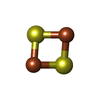 ChemComp-FES: 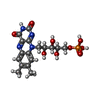 ChemComp-FMN:  ChemComp-SF4: 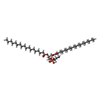 ChemComp-3PE: 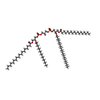 ChemComp-CDL: 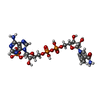 ChemComp-NDP:  ChemComp-ZN: 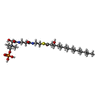 ChemComp-EHZ: 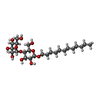 ChemComp-LMT: |
| Source |
|
 Keywords Keywords | MEMBRANE PROTEIN / NADH:Ubiquinone Oxidoreductase / complex I |
 Movie
Movie Controller
Controller Structure viewers
Structure viewers About Yorodumi Papers
About Yorodumi Papers





 yarrowia lipolytica (yeast)
yarrowia lipolytica (yeast)